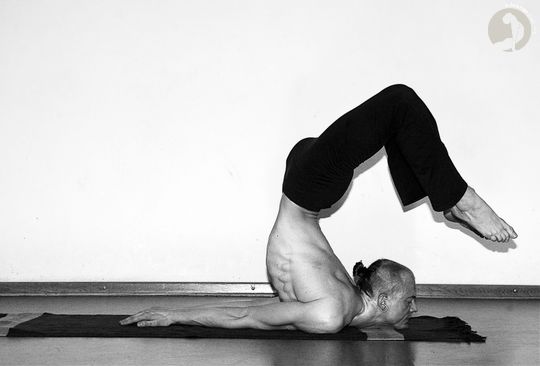Ganda Bherundasana
गण्ड भेरुण्डासन
Gaṇḍa Bheruṇḍāsana

Ganda (गण्ड, Gaṇḍa) = cheek, pat of face including forehead
Bherunda (भेरुण्ड, Bheruṇḍa) = Literally: terrible, frightening, bad;
Bird species; a form of Shiva (शिव, Śiva)
Ganda-Bherunda (गण्डभेरुण्ड, Gaṇḍa-Bheruṇḍa) = two-headed brid from Indian Mythology. Said to feed on Elephants. The
Ganda-Bherunda (गण्दभेरुण्ड, Gaṇda-Bheruṇḍa) was the coat of arms of the royal family of Mysore.
Asana (आसन, Āsana) = Posture, Seat
Ganda Bherundasana (गन्द भेरुण्डासन, Ganda Bheruṇḍāsana) = Posture of Ganda-Bherunda
| Vinyāsa | breath | Dr̥ṣṭi | explanation of movement |
| 1 | IN | añguṣṭhamadhye | lift arms over the side |
| 2 | EX | nāsāgre | splay out fingers, arms far forward, extend arms to the ground, knees to chinbones |
| 3 | IN | bhrūmadhye | lift head, long back |
| 4 | EX | nāsāgre | glide backward, slowly lower down, elbows close to body, Chaturanga Dandasana (चतुराङ्ग दण्डासन, Caturāṅga Daṇḍāsana), lower down |
| 5 | IN | lift legs backward for Viparita Shalabhasana (विपरीत शलभासन, Viparīta Śalabhāsana) | |
| (EX) | backbend, feet close to head toward ground, grab feet with hands | ||
| 5BR | nāsāgre | Ganda Bherundasana (गण्ड भेरुण्डासन, Gaṇḍa Bheruṇḍāsana) | |
| 6 | IN | lift, balance on arms | |
| 7 | EX | nāsāgre | lower down slowly, elbows close to the body, Chaturanga Dandasana (चतुराङ्ग दण्डासन, Caturāṅga Daṇḍāsana) |
| 8 | IN | bhrūmadhye | roll on tops of feet, open the chest, straighten arms, Urdhva Mukha Shvanasana (ऊर्ध्व मुख श्वानासन, Ūrdhva Mukha Śvānāsana) |
| 9 | EX | nābicakre | tuck toes, push back, lift hips, straight arms, Adho Mukha Shvanasana (अधो मुख श्वानासन, Adho Mukha Śvānāsana) |
| 10 | IN | bhrūmadhye | jump feet between hands, straighten the spine half way up, lift your head, |
| 11 | EX | nāsāgre | bring chest all the way in, Uttanasana (उत्तानासन, Uttānāsana) |
| - | IN | bhrūmadhye | lift the head again, straighten spine, palms or finger tips remain on the ground |
| EX | nāsāgre | stand all the way up, arms on sides, Samasthitih (समस्थितिः, Samasthitiḥ) |
legend for the Vinyāsa table:
- The grey part of the table is performed in Aṣṭāṅga-Yoga practice.
- Yellow marked is the position depicted on the photo.
- Vinyāsa:1 = ekam; 2 = dve; 3 = trīṇi; 4 = catvāri; 5 = pañca; 6 = ṣaṭ; 7 = sapta; 8 = aṣṭau; 9 = nava; 10 = daśa; 11 = ekādaśa; 12 = dvādaśa; 13 = trayodaśa; 14 = caturdaśa; 15 = pañcadaśa; 16 = ṣoḍaśa; 17 = saptadaśa; 18 = aṣṭadaśa; 19 = ekonavimśatiḥ; 20 = vimśatiḥ; 21 = ekāvimśatiḥ; 22 = dvāvimśatiḥ; 23 = trayovimśatiḥ; 24 = caturvimśatiḥ; 25 = pañcavimśatiḥ; 26 = ṣoḍavimśatiḥ; 27 = saptavimśatiḥ; 28 = aṣṭovimśatiḥ
- breath: IN = Inhalation; EX = exhalation; 5BR = five breaths
- Dr̥ṣṭi: nāsāgre = to the nose; añguṣṭhamadhye = to the middle of the thumb; bhrūmadhye = in the middle of the eye brows; nābicakre = to the navel; ūrdhvadr̥ṣṭi = upwards; hastāgre = to the tip of the hand; pādayoragre = to the tip of the foot; pārśvadr̥ṣṭi = sidewards

![Way in the Posture [thumb mini]](/typo3temp/assets/images/csm_52__Viparita_Dandasana__Vinyasa_in_1389998cfa_0c4a691cb3.jpg)
![Dvi-Pada Viparita Dandasana [thumb mini]](/typo3temp/assets/images/csm_53__Viparita_Dandasana_38681f28b3_12a2304c38.jpg)
![Eka-Pada Viparita Dandasana [thumb mini]](/typo3temp/assets/images/csm_54__Eka_Pada_Viparita_Dandasana_80ad3b735a_e76ccbf2b2.jpg)
![Viparita Shalabhasana [thumb mini]](/typo3temp/assets/images/csm_56__Viparita_Salabhasana_f7189551e8_5db7a778a2.jpg)
![Ganda Bherundasana [thumb mini solar]](/typo3temp/assets/images/csm_57__Ganda_Bherundasana_d9e76aa119_62dcef447d.jpg)
![Hanumanasana [thumb mini]](/typo3temp/assets/images/csm_58__Hanumanasana_e40137feff_33e7f278a0.jpg)
![Supta Trivikramasana [thumb mini]](/typo3temp/assets/images/csm_60__Supta_Trivikrmasana_e63626341c_cbf8ee1a3f.jpg)
![Digasana [A] [thumb mini]](/typo3temp/assets/images/csm_64__Dighasana_A_677ba665f0_940ad4066a.jpg)
![Digasana [B] [thumb mini]](/typo3temp/assets/images/csm_65__Dighasana_B_2eab4216bd_24da66381c.jpg)
![Utthita Trivikrimasana [thumb mini]](/typo3temp/assets/images/csm_67__Trivikrmasana_0a59a5bead_3306a52193.jpg)